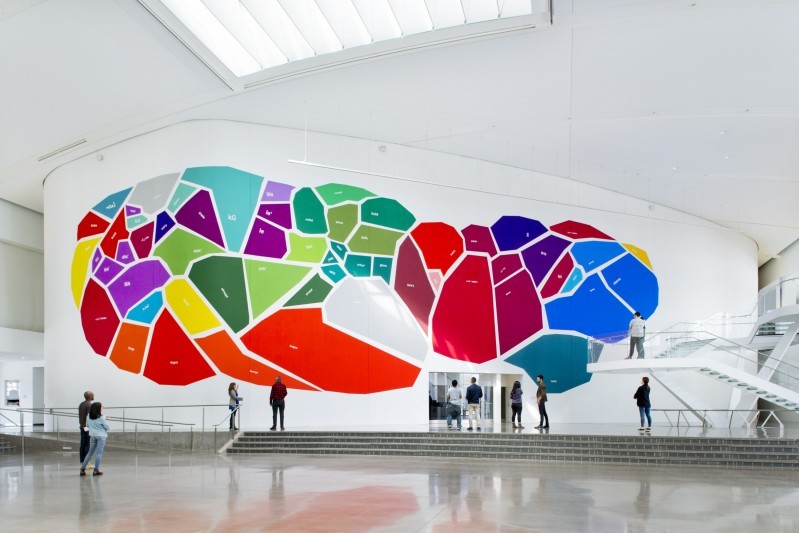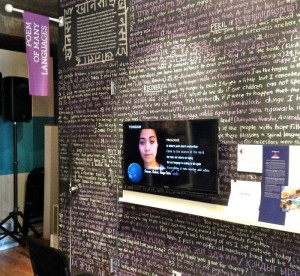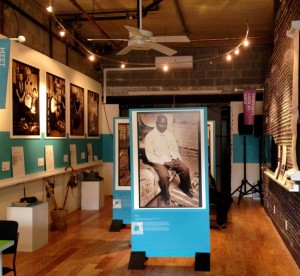Mother Tongues is a photography series, featuring photographs of endangered language speakers in New York, along with recordings and information about their languages, created by Yuri Marder in collaboration with ELA and with support from the National Endowment of the Arts. The series was on display as part of ELA’s residency on Governors Island from May through October 2021. You can also experience a virtual version on the Google Cultural Institute by cllicking here or on the image above.
Also exhibited at ELA’s house on Governors Island was Cinthya Santos-Briones’ Migration Codex, an ongoing interdisciplinary project that takes up pre-Hispanic codices to explore and engage in dialogue the historical, cultural and semiotic links that exist between pre-Columbian peoples and contemporary indigenous migrants from Mexico and Guatemala who live today in the United States. The project includes participatory portraits, drawings and testimonies written in Indigenous languages.
ELA’s NYC language map served as the basis and inspiration for artist Mariam Ghani’s “The Worlds We Speak”, a prominent permanent installation at Delta’s new LaGuardia terminal.


ELA’s work has also been the basis of the two first-ever exhibits devoted to the languages of New York City, first at City Lore Gallery from January through April 2015, then at the Queens Museum from April to July 2016. An estimated 70,000 people saw the two exhibits.
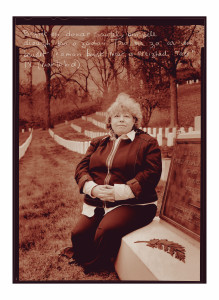 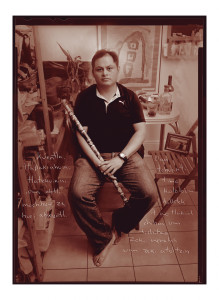 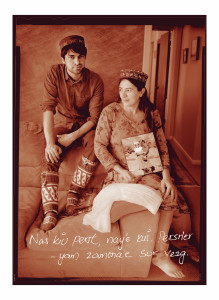 |
At the heart of both exhibits were ten large, high-quality portraits by Yuri Marder, featuring ELA’s local collaborators in New York City, each one of whom speaks a different endangered language. Accompanying several portraits were sound recordings and short written texts.
At the Queens Museum, the main hall featured The Garden of Forked Tongues, a giant mural created by artist Mariam Ghani based on ELA data, in which each of the 59 polygons on the wall represents an endangered language spoken in Queens. Alongside the exhibit, ELA also hosted a day-long open recording session at the museum on May 29, 2016, recording interviews in Hokkien, Cantonese, Kichwa, Tibetan, Nepali, Mustangi, Tamang, Tashelhiyt, and Southern Zaza, not to mention Spanish and English (about language issues). We talked to devout Buddhists, political refugees, visitors from Malaysia, and a career translator for the NY state supreme court, among others. A June 11 ELA roundtable at the museum, “Languages Lost and Found: A Roundtable” featured writers, translators, linguists and practitioners discussing language endangerment, revitalization and multilingualism in both a local (New York) and global context.
At City Lore,“Mother Tongues: Endangered Languages in New York and Beyond”, sponsored by the National Endowment for the Arts, also included a map highlighting New York’s connection to linguistic diversity across the globe, a children’s book section, information on New York City English, and an area where visitors could record their own language. Many visitors contributed to the show by adding a line to the “People’s Khonsay”, an evolving poem in 50 different languages, in their own mother tongue.
“Mother Tongues” was also featured on Channel 7 and Channel 4 News in New York City, as well as on NPR. ELA also organized seven public programs in the gallery space, almost all of them filled to capacity:
- Jan. 29, 2015 – Opening Reception: The exhibition was presented by the curators and artists to an over-capacity crowd.
- Feb. 12, 2015 – Screening of “If These Knishes Could Talk”, a film on the New York accent, presented by director Heather Quinlan and followed by an “Accent Slam”.
- Feb. 18, 2015 – Screening of “Language Matters with Bob Holman”, a PBS film on endangered languages, followed by discussion with poet Bob Holman and ELA director Daniel Kaufman.
- Feb. 26, 2015 – More than Maize & Molé: Nahuatl Language Through Food. Nahuatl teacher and chef Irwin Sanchez demonstrated the preparation of pre-Hispanic Mexican food together with a lesson in Nahuatl food terms.
- Mar. 12, 2015 – Documenting Traditional Garifuna Song in NYC and Belize: A concert with the Garifuna group Libaña Marasa, recorded as part of a larger project to document traditional Garifuna music in NYC and Honduras. Part of the event can be seen on ELA’s Youtube channel.
- Mar. 18, 2015 – Mameloshen: Sharing Songs & Memories of Yiddish-Speaking NYC:
A concert of Yiddish folksongs led by Ethel Raim of the Center for Traditional Music and Dance. Followed with a talk by Ross Perlin on the role of Yiddish in NYC.
- Mar. 28, 2015 – Languages of the Caucasus – Songs from the Lazuri language of Eastern Turkey.
- Apr. 22, 2015 – The People’s Khonsay: The exhibit closed with a reading by Bob Holman and Daniel Kaufman of the “People’s Khonsay”, a collection of favorite expressions and untranslatable words contributed by visitors in their mother tongue over the course of the 3 month exhibit.
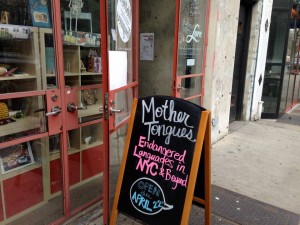 
|

